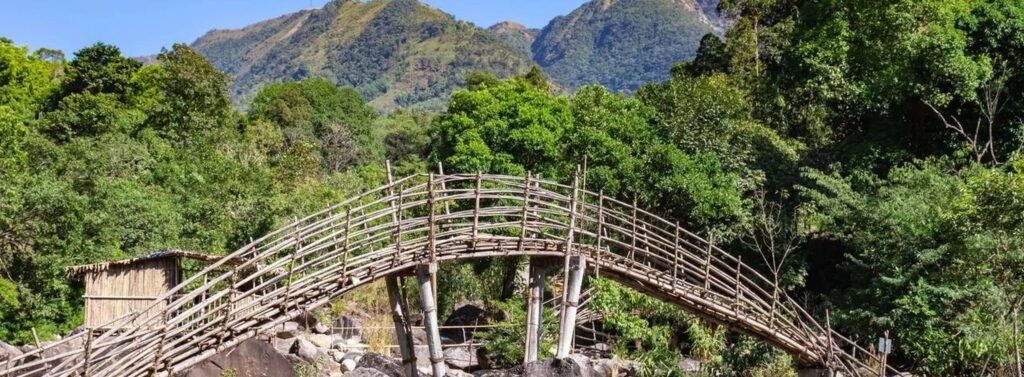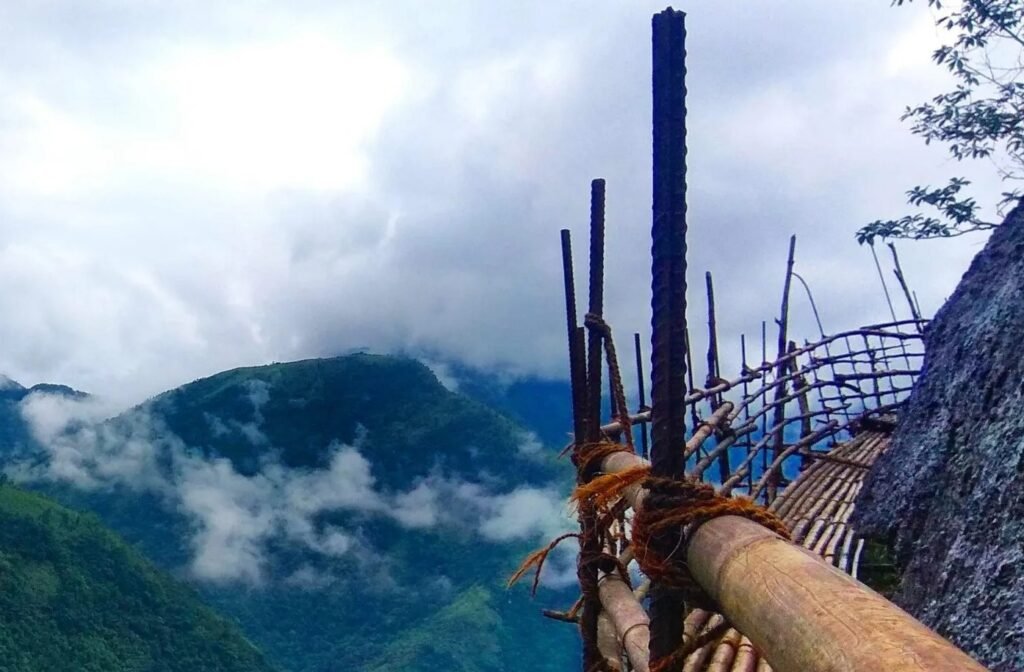Nestled in the lush green heart of Meghalaya, the Bamboo Trek, also known as the Mawryngkhang Trek, is an unforgettable adventure sculpted by the hands of the local Khasi people and shrouded in legend, beauty, and adrenaline. Walk atop swaying bamboo bridges suspended over deep gorges, surrounded by misty cliffs and bursting with history, culture, and natural wonders.
What is the Bamboo Trek Meghalaya?
The Bamboo Trek Meghalaya refers to the Mawryngkhang Trek in the village of Wahkhen, in the East Khasi Hills district. This unique route tests the limits of your courage as you cross bamboo bridges secured with cane ropes—many without metal or nails, zigzagging along towering cliffs and across crystal-clear rivers. The trek has quickly gained attention as one of the most beautiful and daring adventures in Northeast India.

Trip Charges, Fees, and Essentials
- Entry Fee: INR 50–100 per person.
- Guide Charges: Optional, but highly recommended; tips appreciated.
- Tour Packages: Ranges from INR 3,000 for a day-trek (including guide, transfers from Shillong/Guwahati) to more comprehensive Meghalaya tours (upwards of INR 20,000-40,000 for multi-day, multi-site packages).
- Other Fees: INR 50 for car parking.
The Trek Experience
Route, Distance, and Scenery
The trail covers a 3.5–4km round trip, weaving through dense bamboo groves, over the placid Wahrew River, past vertical cliffs (like the Mawkhlieng Cliff), and ending at the iconic U Mawryngkhang Rock. The terrain is challenging—a moderate difficulty level with steep climbs and heart-stopping bridges, but requiring only a day (usually 3–5 hours).
Trek Landmarks
- Wahrew River: First major stop, crossed by a bamboo bridge.
- Mawkhlieng Cliff: Vertical cliff with adrenaline-pumping views.
- Mawmoit Viewpoint: Panoramic landscapes are ideal for photography.
- U Mawryngkhang Rock: The trek’s majestic culmination, shrouded in legend.
What to Carry:
- Water, snacks, and first aid
- Good trekking shoes with grip
- Rain gear (monsoon months)
- Identity card, camera
- Cash for village purchases (no ATMs nearby)
The History and Origins
The Mawryngkhang Trek is a young addition to Meghalaya’s adventure circuit, opened to tourists in 2016 when the villagers of Wahkhen decided to generate sustainable income by sharing their remarkable bamboo craftsmanship with the world. The bridges and trails are built exclusively by locals using traditional skills, making every step on the Trek a testament to indigenous knowledge and innovation.
But the history of the place runs deeper, woven into Khasi folklore. According to legend, “U Mawryngkhang” (the King of Stones) fell in love with a beautiful stone named Kthiang. However, another stone-king, Mawpator, also sought her heart, culminating in a dramatic battle. Mawryngkhang triumphed but lost a hand, and the vanquished Mawpator’s “head” is believed to rest in the gorge below. The gigantic rock at the trek’s end symbolises this mythic king, making the journey not just a thrill-seeker’s paradise but also a walk into living legend.
Wahkhen Village: Gateway to the Trek
The trek starts from Wahkhen Village, about 42–48km from Shillong, easily reached by road, though public transport is sparse. Wahkhen, known as the “Whistling Village” for its unique communication traditions, is mostly home to Khasi people whose lives blend seamlessly with their environment and bamboo heritage.
Population & Economy
While the specific population is small and rural, Wahkhen forms part of East Khasi Hills, with the village sustaining itself through subsistence farming, broom grass, handicrafts, and now, trekking tourism. Locals rely heavily on eco-tourism, registration fees, and providing guiding services.
Natural Beauty
Expect lush valleys, breathtaking waterfalls, deep gorges, and panoramic vistas of the East Khasi Hills. The trek is renowned for its untouched scenery, with wildflowers, fern-laden cliffs, and echoes of whistling birds and cascading streams.
Best Time to Visit
October to April is ideal: the weather is cool and dry, and the trail is safer. Avoid the monsoon (June–September), when rain makes the bamboo pathways dangerously slippery.
Landmarks & Nearby Attractions
Aside from the trek itself, the region’s other highlights include:
- Living Root Bridges at nearby villages
- Dainthlen and Nohkalikai Falls
- Sohra (Cherrapunji) Caves
- Wahkhen’s Whistling School, watch (or hear!) locals engage in their signature whistled communication
Culture and Folklore
Wahkhen is steeped in Khasi culture, from its music and folklore to its architectural ingenuity. Participating in village life, trying local cuisine, and listening to stories of U Mawryngkhang make your adventure deeper than just a trek.
Popular People from This Place
While Wahkhen is a quiet, unassuming village without national celebrities, its fame has grown through local guides and craftspeople who’ve become the faces of the eco-tourism movement in Meghalaya. They have appeared in travel documentaries and blogs, sharing both folklore and environmental stewardship with visitors.
FAQs About Bamboo Trek Meghalaya
How difficult is the Bamboo Trek Meghalaya?
It’s moderately difficult: the route may be short, but it is physically challenging with steep inclines and narrow, swaying bamboo bridges. Some experience with hiking or moderate fitness is helpful.
Is it safe to walk on bamboo bridges?
Yes, the bridges are built and maintained by locals skilled in bamboo engineering. While sturdy, you need to proceed carefully, especially in rainy weather. Always follow your guide’s instructions.
What is the legend behind the trek?
The trek celebrates the tale of U Mawryngkhang, the “King of Stones,” who fought for love and honour. The trek’s destination, a towering rock, is believed to be his resting place, a story still retold by locals.
How do I reach Wahkhen and the Bamboo Trek?
Wahkhen is about 42–48km from Shillong, accessible by car or bike. Public transport is limited; hiring a cab or joining a tour is recommended.
What are the costs involved in the Bamboo Trek?
Entry (INR 50–100), Parking (INR 50/car), optional guide fee. Day-trek packages (including transport) start from INR 3,000, with premium tours costing more if including broader Meghalaya sightseeing.
Do I need a guide for the trek?
Not mandatory, but strongly recommended. Guides share local legends, ensure your safety, and support community tourism.
Is the trek suitable for children or beginners?
Children (over 10) with supervision and fit beginners can attempt it, but only if comfortable with heights and physical exertion.
What should I pack for the trek?
Water, snacks, rain jacket (in season), sturdy shoes, first aid, camera, cash, and an adventurous spirit!
Are there any food or toilet facilities?
Basic refreshments are available at Wahkhen village and the trail entrance. Public restrooms are limited, so plan ahead.
What else can I see nearby?
Include the Living Root Bridges, waterfalls like Nohkalikai and Dainthlen, Shillong city, and village cultural shows in your itinerary.
Final Thoughts
Bamboo Trek Meghalaya isn’t just a trek, it’s a dance on the edge between myth and nature, a journey into wild adrenaline, Khasi tradition, and eco-friendly marvel. Whether you are an adventure junkie, a folklore fan, or a nature lover looking to push your limits, this trail promises an experience above and beyond the ordinary.
Pack your courage, grab your camera, and walk the legendary Bamboo Trail of Meghalaya: a true king’s route, for those daring enough to step on its swaying bridges.
